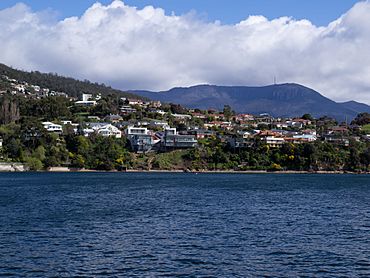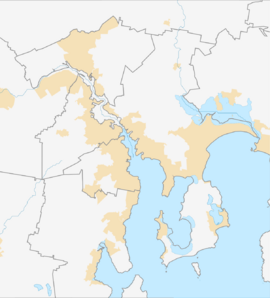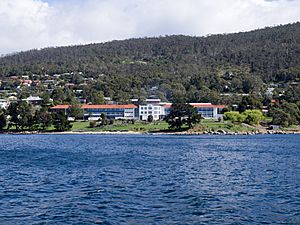Taroona facts for kids
Quick facts for kids TaroonaHobart, Tasmania |
|||||||||||||||
|---|---|---|---|---|---|---|---|---|---|---|---|---|---|---|---|
 |
|||||||||||||||
| Population | 3,070 (2016 census) | ||||||||||||||
| Postcode(s) | 7053 | ||||||||||||||
| LGA(s) | Kingborough | ||||||||||||||
| State electorate(s) | Clark | ||||||||||||||
| Federal Division(s) | Clark | ||||||||||||||
|
|||||||||||||||
Taroona is a lovely suburb in Tasmania, Australia. It's about a 15-minute drive from the center of Hobart, along a pretty road that leads to Kingston. Even though it's close to Hobart, Taroona is actually part of the Kingborough area.
Taroona is bordered on the east by the Derwent River. It has several beaches along its shore. The main beaches where people can visit are Taroona Beach, Hinsby Beach, and Dixons Beach. Beyond Hinsby Beach, you'll find the Alum Cliffs, which are tall cliffs leading to the nearby suburb of Bonnet Hill.
Contents
What Does Taroona Mean?
The name Taroona comes from a word used by the Mouheneener people. It means "chiton," which is a type of sea snail. You can find these small sea creatures on rocks along the Taroona coastline when the tide is out.
Taroona's Past
First People of Taroona
For thousands of years, the land where Taroona now stands was home to the Mouheneener people. They were a group of Aboriginal people who moved around the land. They lived here for as long as 35,000 years before Europeans arrived. You can still find piles of shells left by the Mouheneener people along Taroona's beaches. These are called shell middens and show where they used to eat seafood.
European Settlers Arrive
This area was first known as Crayfish Point. Early records show that people came here to catch crayfish.
The first European settlers came to Taroona in the early 1800s. They were people who had moved from Norfolk Island. For the rest of that century, the area was mostly used for farming. Not many people lived here back then.
In the mid-1890s, a man named Clarendon James Cox Lord bought a property. He named it Taroona, after the Aboriginal word for sea shell. Lord built a beautiful home and also opened a tea room. Visitors could enjoy treats like strawberries and cream while looking out at the River Derwent.
In the early 1900s, more large and fancy houses were built. People from Hobart also built small beach houses for seaside holidays. The Taroona Post Office opened on August 2, 1906.
Near Taroona Beach, there is a special grave. It belongs to a young sailor named Joseph Batchelor. He died on a ship called Venus in 1810 and was buried there. This is thought to be the oldest European grave in Tasmania. It is now a protected historical site.
After World War II, Taroona grew a lot. Many new homes were built, and more people moved in. Taroona became a "commuter suburb," meaning people lived there but traveled to Hobart for work. Because of this, Taroona doesn't have many shops or big stores. Most early shops closed because people preferred larger supermarkets elsewhere.
The 1967 Bushfires
In February 1967, southern Tasmania faced terrible wildfires. Taroona was one of the closest suburbs to Hobart that was hit hard. The fires swept through the area in the afternoon, causing a lot of damage. Many homes were destroyed. Children and residents ran to the river for safety. Many people survived because the water protected them from the flames.
Schools in Taroona
Taroona High School
In 1958, a public high school was built in Taroona. It was placed on a large piece of land near the Channel Highway, right in the middle of the suburb. It also has a view of the Derwent River.
In 1960, Taroona Primary School moved to the same site. Before that, it was in an older building further south. The old primary school buildings were then used for kindergarten and pre-school. Sadly, they burned down in 1974. New kindergarten and pre-school buildings were then built next to the primary school.
Taroona High School and Taroona Primary School are separate schools. However, they do share one sports oval.
The high school first taught students from grades 7 to 11. But in 1962, a new system for older students began. Grade 11 students then went to Hobart Matriculation College. At its busiest, Taroona High School had about 1200 students in the 1960s. Students came from many places, including Ferntree, South Hobart, Sandy Bay, and Kingston.
Today, there are about 1150 students at the high school. They mostly come from the southern suburbs of Hobart. The current principal is Matthew Bennell.
Famous People from Taroona
Taroona was the childhood home of Queen Mary of Denmark. She was born in Tasmania. She went to Taroona High School by the river. Later, she finished high school at Hobart College in Mount Nelson. After that, she studied at the University of Tasmania.
In music, Judith Durham, the lead singer of The Seekers, lived in Taroona as a young girl. She went to the Fahan School in Sandy Bay. She later moved back to Melbourne in 1956 and joined The Seekers in 1963.
Gwen Harwood, a famous poet, lived in Taroona with her family for several years in the 1950s. Louise Lovely, who was Australia's first actress to become famous in Hollywood, spent her later years in Taroona until she passed away in 1980.
David Bartlett, who was the Premier of Tasmania in 2008, also grew up in Taroona.
The Shot Tower
South of Taroona, on the Channel Highway, you can find a very unusual old building called the Shot Tower. This tower is 48 meters (157 feet) tall. It is 10 meters (32 feet) wide and shaped like a cylinder. Joseph Moir built it in 1870 using sandstone blocks from nearby quarries.
The tower was used to make lead shot. Workers would drop melted lead through a sieve at the top of the tower. As the lead fell, it would cool down and become round. By the time it hit the water at the bottom, it was cold and perfectly spherical. You can climb the 259 steps to the top of the tower. From there, you get an amazing view of the Derwent River.




